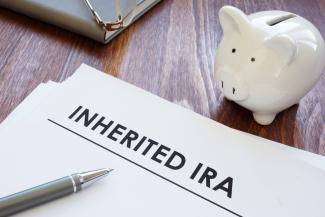
Spouse IRA Beneficiaries: Handling New Restrictions for Inherited IRAs.
Spouse beneficiaries of IRAs have always enjoyed exclusive benefits. While this is still the case, the proposed RMD regulations create new limitations that must be managed so as to avoid unintended tax consequences.
A spouse who inherits an IRA (spouse beneficiary) has more options than those available to other beneficiaries. While all beneficiaries may keep IRAs they inherit in beneficiary IRAs, only a spouse beneficiary may move an inherited IRA to their own IRA. The new proposed RMD regulations, published on February 24, 2022, include new limitations when moving an inherited IRA to a spouse beneficiary’s own IRA. Exceeding these limitations could result in excise tax and unintended tax consequences for the amounts.
The options for a spouse beneficiary
A spouse beneficiary of an IRA may choose any of the following options:
- Keep the amount in a beneficiary IRA: This option is available regardless of whether the spouse is the sole primary beneficiary of the IRA.
- Treat the inherited IRA as their own: This option is available only if the spouse is the sole primary beneficiary of the IRA, or
- Rollover the inherited IRA to their own IRA: This option is available regardless of whether the spouse is the sole primary beneficiary of the IRA.
The following is a high level explanation of the rules that apply to each option, including applicable deadlines.
1. Beneficiary IRA option
The financial institution debits the assets from the decedent’s IRA and credits the spouse’s beneficiary IRA. This movement of assets, done as a transfer or journal, is nonreportable. Nonreportable means no tax forms and no tax reporting to the IRS.
The IRA custodian is required to register the beneficiary IRA in the names of the decedent and the spouse beneficiary. For example, if Jack Sprat died and the beneficiary is his surviving spouse, Jill Parrott, the beneficiary IRA would be titled “Jill Parrott as beneficiary of Jack Sprat.” Any other format works if it shows that Jill inherited the IRA from Jack.
In addition, the IRA should be designated on the IRA custodian’s tax platform as a beneficiary IRA so that distributions are reported as ‘death distributions.’ Death distributions are designated as such by the IRA custodian inputting Code 4 in Box 7 of IRS Form 1099-R. Code 4 lets the IRS know that the distribution is from a beneficiary account, for which one of the benefits is that the 10% early distribution penalty does not apply.
Planning tip: The spouse beneficiary may switch to option 2 or 3.
Distribution requirements for beneficiary IRAs
The distribution requirements for the beneficiary IRA are determined by whether the IRA owner died before the required beginning date (RBD), which is April 1 of the year that follows the year in which the owner reached age 72. The RBD is the deadline by which an IRA owner must start taking RMDs.
If the owner died before the RBD
The spouse beneficiary may choose between either of the following:
- The 10-year rule: Distributions are optional for the first nine years that follow the year in which the IRA owner died, and the account must be fully distributed by the end of the tenth year.
- The life expectancy rule: Distributions would be taken over the surviving spouse’s single life expectancy, beginning by the later of December 31 of the year that follows the year in which the IRA owner died or the year in which the IRA owner would have reached age 72. The life expectancy would be recalculated, which means that the Single Life Table is consulted each year to determine the life expectancy factor.
If the IRA owner died on or after the RBD
The spouse beneficiary must take distributions over the longer of the remaining single life expectancy of the decedent or the life expectancy of the spouse beneficiary. If the decedent’s life expectancy is used, it is determined in the year of death and is not recalculated (one is subtracted for each subsequent year). However, if the life expectancy of the spouse beneficiary is used, it is recalculated.
2. ‘Treat as own’ option
This option is available only if the surviving spouse is the sole primary beneficiary of the IRA and has an unlimited right to distributions.
The spouse beneficiary elects this option under one of the three methods listed below.
How the election is made
There are three options for a spouse beneficiary who wants to treat an inherited IRA as their own.
- The surviving spouse re-designates the IRA in their name as the owner rather than the beneficiary.
- Deemed election: (i) Any amount in the IRA that would be required to be distributed to the surviving spouse as beneficiary is not distributed within the period required (see Beneficiary IRA option above)
- Deemed election (ii) the surviving spouse makes a regular IRA contribution to the account.
Caution: New deadline
Under current regulations, a surviving spouse was allowed to make this election at any time. But the proposed regulations require this election to be made no later than:
- The calendar year in which the surviving spouse reaches age 72; and
- The calendar year following the calendar year of the IRA owner’s death.
If the spouse beneficiary misses this deadline, the third option, the rollover option, can be used to move the inherited IRA to the surviving spouse’s own IRA.
This election is irrevocable.
Distribution requirements
When this (treat as own) election is made, the IRA is treated as the spouse beneficiary’s own IRA. Therefore, none of the beneficiary distribution rules apply. Instead, the owner distribution rules apply, where:
- Distributions before age 59½ are subject to the 10% early distribution penalty unless an exception applies.
- RMDs must begin no later than the year the spouse beneficiary reaches age 72. Any RMDs for the year in which the spouse beneficiary reaches age 72 can be taken as late as the spouse beneficiary’s RBD. And,
- All rollover and transfer rules apply with the spouse beneficiary as owner and not as beneficiary.
This election is effective for the year the spouse beneficiary makes the election, with one exception. Under that exception, if the IRA owner died before taking any RMD due for the year of death, the spouse beneficiary must take that RMD. That RMD for the year of the owner’s death may not be retained in the spouse’s (own) IRA, even if the election is made in the year of the IRA owner’s death. The RMD for the year of death is required to be taken by the end of the year in which the IRA owner died.
Planning tip: The beneficiary IRA option allows the spouse to take distributions that are exempt from the 10% early distribution penalty and should be chosen instead—if the spouse beneficiary is under age 59½ and might take distributions before reaching age 59½.
3. Rollover option
The spouse beneficiary takes a distribution from the inherited IRA and rolls over the amount to their own IRA within 60 days of receipt.
This option is available whether the spouse beneficiary is the sole beneficiary of the IRA or beneficiary of a partial amount.
How the election is made
The spouse beneficiary makes this election by taking a distribution from the beneficiary IRA and rolling over the amount to the spouse’s own IRA. The rollover is subject to regular IRA rollover rules, including the following:
- The rollover must be completed within 60 days of receipt. The 60-day rollover deadline can be waived if certain conditions are met. (These are beyond the scope of this article).
- The rollover is subject to the one-per-year IRA-to-IRA rollover rule. As a result, this option is available only if this rollover would be the only IRA-to-IRA rollover for the spouse beneficiary during the 12-month period in which it occurs. And,
- The rollover may not include amounts not eligible for rollover, including RMD amounts.
Caution: New limitation on eligible rollover amount
RMDs are not eligible to be rolled over.
Under current regulations, the RMD amount not eligible for rollover is limited to any RMD that the IRA owner should have taken for the year of death and did not, and any RMD that the spouse beneficiary should have taken but did not.
For example, if the IRA owner died before the RBD, and
-
The spouse beneficiary elected the 10-year rule: Only the balance in the 10th year would be the RMD and ineligible to be rolled over. Distributions before then are optional and therefore are not RMDs. Or,
-
The spouse beneficiary elected the life expectancy rule: RMDs would be taken over the spouse beneficiary’s life expectancy, beginning by the later of:
- December 31 of the year that follows the year in which the IRA owner died, and
- December 31 of the year in which the IRA owner would have reached age 72. Amounts ineligible for rollover would be any RMD as of the required beginning year.
The proposed RMD regulations take it further by including in the definition of RMD for the purpose of this rollover option—any RMD amount that the spouse beneficiary would have had to take if the life expectancy option was elected during a span of years. This ’span of years’ begins the later of the year in which the decedent would have reached age 72 or the year the spouse beneficiary would have reached age 72 and ends the year that the distribution (that would be rolled over) is taken from the beneficiary IRA. This limitation applies only if the owner died before the RBD.
This election is irrevocable.
Distribution requirements
The distribution rules are the same as those that apply under the “treat as own” option above.
Planning opportunities
The flexibility to choose from these options provides planning opportunities that must not be overlooked. These include the following:
- Avoiding the 10% early distribution penalty: Distributions before age 59½ are subject to a 10% additional tax (early distribution penalty) unless an exception applies. One of the exceptions is distributions due to death—which are those made from beneficiary accounts. A spouse beneficiary who is under age 59½ years old should choose this option to get that protection. The amount can be moved to the spouse’s own IRA at age 59½ or later.
- Minimizing distribution: RMDs from beneficiary IRAs are calculated using the Single Life Table and produce a larger RMD amount than the Uniform Life Table. The Uniform Life Table is used to calculate RMDs for the spouse’s own IRA. Moving the inherited amounts to the spouse beneficiary’s own IRA—ideally, before beneficiary RMDs are required to begin, would reduce RMD amounts. This is a practical solution for those who want to minimize RMDs.
- Succession planning: A successor beneficiary of a surviving spouse has a maximum distribution period of 10 years. Depending on the surviving spouse’s age and the age of the IRA owner at death, this period could be shorter. Moving the inherited account to the spouse beneficiary’s own IRA could provide a longer distribution period for the successor beneficiary.
- Roth IRAs: There is no RMD for Roth IRA owners and thus no RBD for a Roth IRA owner. The distribution options for a Roth IRA are the same regardless of the owner’s age at death. However, beneficiary Roth IRAs are subject to RMD rules that apply to a traditional IRA when the traditional IRA owner dies before the RBD. A spouse beneficiary who wants to avoid RMDs should move the inherited Roth IRA to their own Roth IRA.
The right option for a spouse beneficiary is the one that minimizes taxes, including avoiding the 10% early distribution penalty. Other rules to consider include planning for successor beneficiaries if that is important to the spouse beneficiary. A good strategy is to create a beneficiary profile for the spouse and successor beneficiaries to help ensure that all factors are considered.

